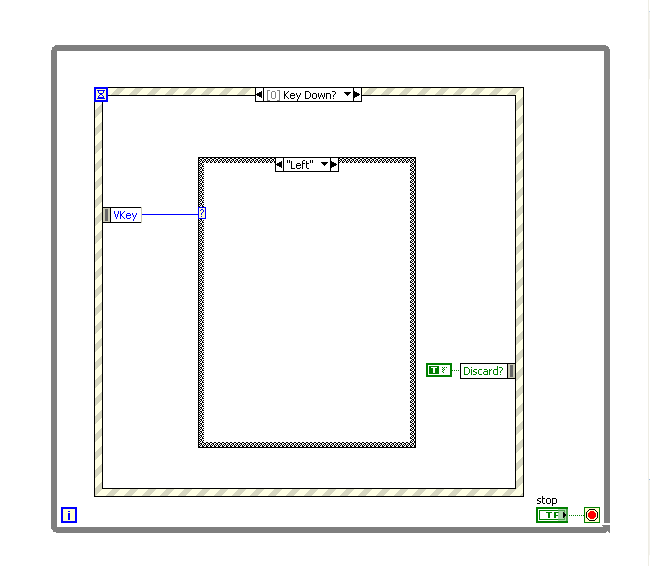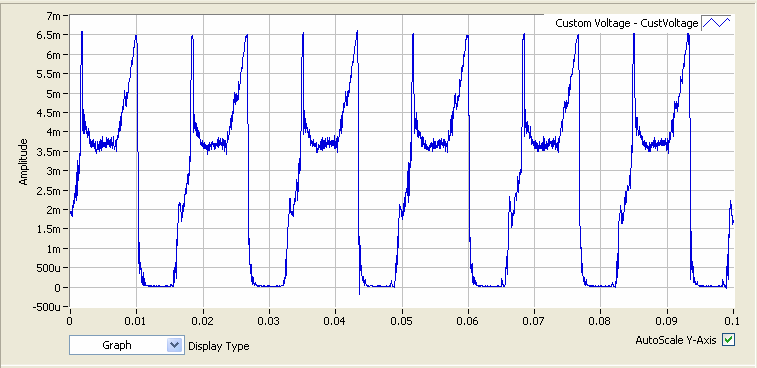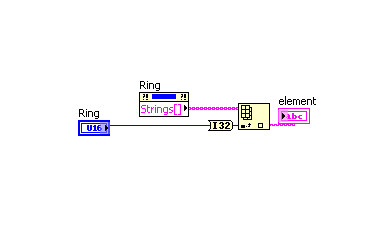-
Posts
360 -
Joined
-
Last visited
-
Days Won
6
Content Type
Profiles
Forums
Downloads
Gallery
Posts posted by ASTDan
-
-
QUOTE (tcplomp @ Apr 21 2008, 02:00 AM)
To http://forums.ni.com/ni/board/message?board.id=170&view=by_date_ascending&message.id=247057#M247057' target="_blank">understand a little bit what Yen is talking about.I read that very good thread and I have an idea. Is it posible to dynamicly register the timeout event? That way I can turn it on and off as needed.
Thanks
Dan
-
Thanks for the idea of the 2 event loops.
I feel so naughty using 2 event loops in one app.
Dan
-
My use case is I have a Custom User event I created. The user event is my device tells me I have data. When my device tells me I have data I fire my Custom User event. What I want is a timeout on this custom user event. Basicaly if I don't see data from my device in say 1 minute, ping the device to see if it is still there running. I don't want my timout reset by somebody clicking away on my user interface.
Does that make sense?
QUOTE (tcplomp @ Apr 19 2008, 11:39 AM)
This can be done by placing just two cases inside an event structure, one for the timeout and one for the event. Upon a 'event-specific timeout' you can trigger a user event in the main event structure. If the event doesn't timeout (eg. just happens) you could handle the code in the 'single event-event structure' or trigger another user event.Could you post a quick example of this?
Thanks
Dan
-
Hello,
I have an idea/is this possible question.
When using an event structures is it posible to timeout if a certain event didn't happen. I know right now I can time out if no events for the enire structure didn't occured in x amount of time. I was wondering if I can time out only if a specific event didn't occur i.e. user event.
Thanks
Dan
-
Thanks Jim!
Just the tip I was looking for.
I am a big open G fan. I tell all my friends about it.
Have a beer on me. :beer:
Dan
-
1 Beer :beer: as ordered. Don't drink it to fast.
Hmmmm. This complicates things. The string array I am actually using has text and numbers, but the first column will always be numeric. Is there an easy way to do this? Right now I am playing around with the pointer array that is coming out of the Sort 2D VI.
Dan
This is what I came up with quick and dirty
-
Hello,
Am I crazy
 ? I can't get this to work right. Why isn't my 0 column sorted?
? I can't get this to work right. Why isn't my 0 column sorted? Please help answer what I hope is a dumb question.
Thanks
Dan
-
Sweeeeeet Ride
-
So if I see crelf ridding on his unicycle wearing a beenie :thumbup: I need to stop my LabVIEW programming while driving and pay attention?
-
Wow I never realized it was tied to the project. No wonder I missed that. Thanks!
Learn something new every day
-
Did you try adding the delay right after you send the T1 command?
Dan
-
The advantage would be I could understand how it works. I haven't been able to understand the conditional disable strucure.
Granted it doesn't take much to confuse me.
Dan
-
I think it would be cool if the disable structure had an input like the Case structure i.e. boolean, enum, string, etc
Dan
-
AMAZING!!!!
-
In my humble opinion using the event structure gives you much more flexiblity i.e you could change the amount you want to increment the control by, put limits on it, change colors, etc.
Also it makes your code a lot easier to read. Everything is in the block diagram not buried somewhere in the property of the control. You are also not limited by what NI decides to give you.
My $.02, or maybe $0.01. If I switch to euros do I get $.03?
Dan
-
-
My advise is to run the VI analyizer when you are done.
I tells you if you have documentation problems etc. I assume that is what NI uses on your application.
http://www.ni.com/toolkits/vi_analyzer.htm
Dan
-
Hello,
Does anyone know if I can hook up 2 computers to monitor a single RS485 device?
I can set my device to continously send out data. So the computers don't need to send data to the device they just need to receive it.
Will I run into loading, or ground loop issues, etc.?
Thanks
Dan
-
OK I think I have found the problem.
My poopy power supply is not a nice clean waveform and the strain gauge has some magic filtering on it. The combination of those 2 produce the wavform I have been seeing.
Dan
-
I have the gray wire Connected to the negative terminal of my power supply and the white wire connected to the positive terminal of my power supply (using a RJ 50 cable). I have checked all the channels. Could my cable be bad?
Dan
QUOTE (AnalogKid2DigitalMan @ Mar 11 2008, 01:22 PM)
Dan:Are you sure you are reading the correct channel for the pins you are wired up to? That almost looks like 60Hz AC power line noise from an unwired adjacent channel. Peak is less than 7mV (0.007).
Also the peak is really 70mV
I had to turn on the Scale using Excitation. I have the excitation set to 10V.
Thanks
Dan
-
Hello,
I have a NI 9237 with a Compaq DAQ chasis. I have hooked up a power supply to the AI + and AI - Input terminals. When I look at my signal in Max I get the attached waveform. I have looked at the input signal with my scope and it doesn't look like the attached waveform. The peak value of the waveform seems to be the desired value.
Any Advice?
Thanks
Dan
-
It is definatly posible to do what you want in LabVIEW.
Here is a link about Property nodes in LabVIEW
http://zone.ni.com/reference/en-XX/help/37.../property_node/
To create a property node right click on your control in the block diagram and select Create\Property Node
After creating the property node you can right click on the property node and select the help for more information on what that specific property node does.
I don't know of a manual for property nodes in LabVIEW.
Dan
-
-
QUOTE(shoneill @ Mar 6 2008, 12:39 PM)
I don't know how I got them to work. You might want to try setting the TermChar to True in the Init VISA. This enables VISA to be able to recognize TermChar. Also the default is LF to change to CR do the following. There are also some other interesting events that my be applicable i.e. Serial break 0xA is the hex equivalent of a linefeed character (\n). Change the termination char to 0xD for message strings that terminate with a carriage return (\r). On the other hand, isn't this basically what the VISA read does in the background with "ASRLEndIn" set to "TermChar" ?Events allow VISA to trigger a Read. The "ASRLEndIn" set to "TermChar" tells VISA where to stop reading.I would aggree you may have to do some buffering on a high baud serial comunication.What I like about Events is I can trigger my read on something usefull. Not just reading whatever is on the serial port every x seconds. This can save parsing headaches.My $0.02DanQUOTE(Aaron L @ Mar 6 2008, 02:11 PM)
Dan,I was able to take your example and get it to work. This is the first code that seems to do what I want. I'll have to try it at full speed to see how it handles things. Attached is a VI with the basic program.Thanks!You don't need that wait before enabling the event. When you create the event that is telling VISA to wait until it sees a Term Char on the serial port.Dan






Timeout on Certain Event
in Application Design & Architecture
Posted
That's right!! I forgot about the -1 shift register trick.
Thanks for all the ideas!
Dan